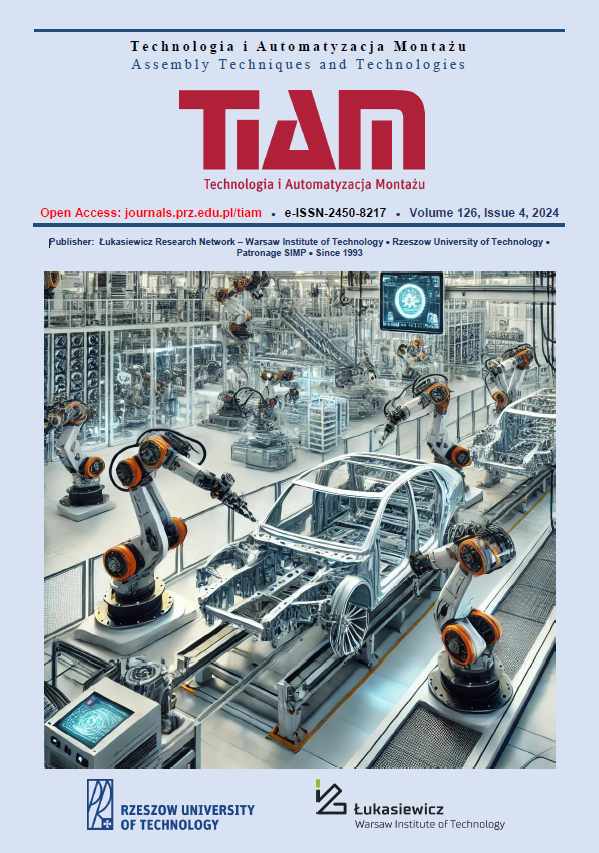Abstract
The aim of the study was to assess the effect of environmental ageing on the load capacity of single-lap adhesive joints made of EN AW-2024-T3 aluminum alloy, subjected to and not subjected to pneumatic shot peening. Adhesive joints were made using two-component epoxy adhesive Loctite EA 3430. Half of the formed joints were strengthened by pneumatic shot peening of the overlap zone. The shot peening time was 120 s, the ball diameter was 1.0 mm, and the compressed air pressure was 0.5 MPa. The adhesive joints were then subjected to different variants of ageing in natural conditions. Individual variants differed in the length of ageing. The next step was to examine the load capacity of the adhesive joints using a static tensile test. The results were subjected to statistical analyzes, including analysis of variance (ANOVA), regression and correlation analysis, and Student's t test. Based on the analyzes, it was found that for the assumed range of input factor variability, ageing of joints not subjected to shot peening increased their load capacity by 38%. Aging of joints strengthened by shot peening resulted in a 62% decrease in their load capacity. The ageing length had a significant effect on the load capacity of the adhesive joints.
References
Bahrami, B., Ayatollahi, M. R., Beigrezaee, M. J., da Silva, L. F. M. (2019). Strength improvement in single lap adhesive joints by notching the adherends. International Journal of Adhesion and Adhesives, 95, 102401.
Belingardi, G., Goglio, L., Tarditi, A. (2002). Investigating the effect of spew and chamfer size on the stresses in metal/plastics adhesive joints. International Journal of Adhesion and Adhesives, 22 (4), 273-282.
Bowditch, M.R. (1996). The durability of adhesive joints in the presence of water. International Journal of Adhesion and Adhesives, 16 (2),73-79.
Çalık, A. (2016). Effect of adherend shape on stress concentration reduction of adhesively bonded single lap joint. Engineering Review, 36(1), 29-34.
Dobrzański, L. A. (2010). Leksykon Materiałoznawstwa. Praktyczne zestawienie norm polskich, zagranicznych i międzynarodowych. Cz. 4, rozdział 1: Metale nieżelazne i ich stopy. Wydawnictwo Verlag Dashofer.
Durmuş, M., Akpinar, S. (2019). The Experimental and Numerical Analysis of the Adhesively Bonded Three-step-Lap Joints with Different Step Lengths. Theoretical and Applied Fracture Mechanics, 105, 102427.
Godzimirski, J., Jagiełło, A. (2018). Effect of surface treatment cold-work hardening after adhesive curing on strength of adhesive lap joints. Technologia i Automatyzacja Montażu, 4, 43-49.
Henkel Polska Sp.z o.o (24.06.2024). Technical Data Sheet Loctite EA 3430. chrome-extension://efaidnbmnnnibpcajpcglclefindmkaj/https://datasheets.tdx.henkel.com/LOCTITE-EA-3430-en_GL.pdf
Hirulkar, N.S., Jaiswal, P.R., Reis, P.N.B., Ferreira, J.A.M. (2020). Effect of hygrothermal aging and cyclic thermal shocks on the mechanical performance of single-lap adhesive joints. International Journal of Adhesion and Adhesives, 99, 102584.
Morcos, M., Challita, G., Legrand, V., Khalil, K., Casari P. (2022). Impact strength of thermally aged double lap adhesively bonded joints. International Journal of Adhesion and Adhesives, 112, 103029.
Ozga, E. (2023). Wpływ pneumokulkowania na nośność połączeń klejowych ze stopu aluminium EN AW-2024-T3. [Rozprawa doktorska]. Politechnika Rzeszowska im. Ignacego Łukasiewicza.
Polski Komitet Normalizacyjny. (2009). Kleje - Oznaczanie wytrzymałości na ścinanie przy rozciąganiu połączeń na zakładkę (PN-EN 1465:2009).
Polski Komitet Normalizacyjny. (2018). Aluminium i stopy aluminium – Blachy, taśmy i płyty – Część 2: Własności mechaniczne (PN-EN 485-2+A1:2018-12).
Polski Komitet Normalizacyjny. 2022. Kleje - Oznaczenie głównych wzorców zniszczenia połączeń klejowych (PN-EN ISO 10365:2022-07).
Rojek, M. (2011). Metodologia badań diagnostycznych warstwowych materiałów kompozytowych o osnowie polimerowej. Open Access Library, 2.
Szabelski, J., Domińczuk, J., Kuczmaszewski, J. (2019). Wpływ ciepła na właściwości połączeń klejowych. Wydawnictwo Politechniki Lubelskiej.
Zhao, X., Adams, R. D., da Silva, L. F. M. (2011). Single Lap Joints with Rounded Adherend Corners: Stress and Strain Analysis. Journal of Adhesion Science and Technology, 25(8), 819-836.
Zielecki, W. (2008). Determinants determining the strength properties of adhesive joint. [Rozprawa habilitacyjna ]. Uniwersytet Techniczny w Koszycach.
Zielecki, W., Bielenda, P., Ozga, E. (2021). The influence of thermal shock on the load capacity of cylindrical adhesive joints made of EN AC-ALSI7-Mg0.3 aluminum alloy and glass-epoxy composite EP405-GE. Technologia i Automatyzacja Montażu, 4, 34-42.
Zielecki, W., Guźla, E., Bielenda, P. (2021). The influence of natural seasoning on the load capacity of cylindrical adhesive joints. Technologia i Automatyzacja Montażu, 3, 15-24.


